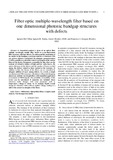Mostrar el registro sencillo del ítem
Fiber optic multiple-wavelength filter based on one dimensional photonic bandgap structures with defects
| dc.creator | Del Villar, Ignacio | es_ES |
| dc.creator | Matías Maestro, Ignacio | es_ES |
| dc.creator | Arregui San Martín, Francisco Javier | es_ES |
| dc.date.accessioned | 2018-03-27T10:02:35Z | |
| dc.date.available | 2018-03-27T10:02:35Z | |
| dc.date.issued | 2004 | |
| dc.identifier.citation | I. Del Villar, I. R. Matias and F. J. Arregui, "Fiber-optic multiple-wavelength filter based on one-dimensional photonic bandgap structures with defects," in Journal of Lightwave Technology, vol. 22, no. 6, pp. 1615-1621, June 2004. doi: 10.1109/JLT.2004.827668 | en |
| dc.identifier.issn | 0733-8724 (Print) | |
| dc.identifier.issn | 1558-2213 (Electronic) | |
| dc.identifier.uri | https://hdl.handle.net/2454/28090 | |
| dc.description.abstract | In this paper, a theoretical analysis is given of an optical fiber multiple-wavelength tunable filter based on a onedimensional (1-D) photonic bandgap (PBG) structure with four defects. To understand the positioning of the modes in the bandgap, a previous analysis of structures with one and two defects is performed. By adequate parameterization, it will be possible to control the central wavelengths of the various filters of the device. Parameters responsible for this effect are the contrast of refractive indexes of high- and low-index layers, the optical thickness of the defects, and the number of layers stacked among the defects related to those stacked at the extremes. In addition to this, the finesse of the filters can be controlled by the adequate addition of layers among defects. As a result, a simple 1-D PBG structure with defects will permit designing almost any multiple-wavelength filter, with immediate application in the treatment of wavelength-division- multiplexed (WDM) signals. The possibility of the tunability of this device can be introduced if materials are included whose refractive index changes with some parameter, such as temperature, voltage, or strain. As an example, liquid crystals change their refractive index with an applied voltage, leading to a shift of the central wavelengths of the filters. | en |
| dc.description.sponsorship | This work was supported by Spanish Ministerio de Ciencia y Tecnologia and FEDER Research Grants CICYT-TIC 2003-00909 and CICYT-TIC 2001-0877-C02-02; Gobierno de Navarra and FPU MECD Grant. | en |
| dc.format.mimetype | application/pdf | en |
| dc.language.iso | eng | en |
| dc.publisher | IEEE | en |
| dc.relation.ispartof | Journal of Lightwave Technology Vol. 22, No. 6, June 2004 | en |
| dc.rights | © 2004 IEEE. Personal use of this material is permitted. Permission from IEEE must be obtained for all other uses, in any current or future media, including reprinting/republishing this material for advertising or promotional purposes, creating new collective works, for resale or redistribution to servers or lists, or reuse of any copyrighted component of this work in other works. | en |
| dc.subject | Diffraction | en |
| dc.subject | Optical fiber filters | en |
| dc.subject | Coupled mode analysis | en |
| dc.subject | Non-homogeneous media | en |
| dc.title | Fiber optic multiple-wavelength filter based on one dimensional photonic bandgap structures with defects | en |
| dc.type | Artículo / Artikulua | es |
| dc.type | info:eu-repo/semantics/article | en |
| dc.contributor.department | Ingeniería Eléctrica y Electrónica | es_ES |
| dc.contributor.department | Ingeniaritza Elektrikoa eta Elektronikoa | eu |
| dc.rights.accessRights | Acceso abierto / Sarbide irekia | es |
| dc.rights.accessRights | info:eu-repo/semantics/openAccess | en |
| dc.identifier.doi | 10.1109/JLT.2004.827668 | |
| dc.relation.publisherversion | https://doi.org/10.1109/JLT.2004.827668 | |
| dc.type.version | Versión aceptada / Onetsi den bertsioa | es |
| dc.type.version | info:eu-repo/semantics/acceptedVersion | en |
| dc.contributor.funder | Gobierno de Navarra / Nafarroako Gobernua | es |


